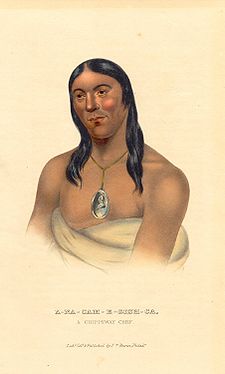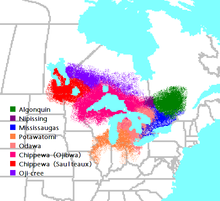- Saulteaux
-
The Saulteaux (pronounced
 /ˈsoʊtoʊ/, soh-toh; also written Salteaux and many other variants) are a First Nation in Ontario, Manitoba, Saskatchewan, Alberta and British Columbia, Canada.
/ˈsoʊtoʊ/, soh-toh; also written Salteaux and many other variants) are a First Nation in Ontario, Manitoba, Saskatchewan, Alberta and British Columbia, Canada.Contents
Ethnic classification
The Saulteaux are a branch of the Ojibwe nations. They are sometimes also called Anihšināpē (Anishinaabe). Saulteaux is a French term meaning "people of the rapids," referring to their former location about Sault Ste. Marie. Because of their location, they farmed little and were mainly hunters and fishers.
Location
The Saulteaux were originally settled around Lake Superior and Lake Winnipeg, principally in the Sault Ste. Marie and northern Michigan areas. White Immigrant Canadians and Americans gradually pushed the tribe westwards to Manitoba, Saskatchewan and Alberta, with one community in British Columbia. Today most of them live in the Interlake District; Swan River, Duck Bay, Camperville, the southern part of Manitoba, and in Saskatchewan (Kamsack and surrounding areas); because they were forced to moved to land ill-suited for European crops, they were able to keep much of their newly settled land. Generally, the Saulteaux are divided into three major divisions.
Ontario Saulteaux
Eastern Saulteaux, better known as the Ontario Saulteaux, are located about Rainy Lake, and about Lake of the Woods in Northwestern Ontario and southeastern Manitoba. Many of the Ontario Saulteaux First Nations are signatories to Treaty 3. Their form of Anishinaabemowin (Anishinaabe language) is sometimes called Northwestern Ojibwa language (ISO 639-3: OJB) or simply as Ojibwemowin (Ojibwe language), though English is the first language of many members. The Ontario Saulteaux culture is that of the Eastern Woodlands culture.
Manitoba Saulteaux
Central Saulteaux, better known as Manitoba Saulteaux, are found primarily in eastern and southern Manitoba, extending west into southern Saskatchewan. During the late 18th century and early 19th century, as partners with the Cree in the fur trade, resulted in the Saulteaux extending themselves from southern Manitoba, northwest into the Swan River and Cumberland districts of west-central Manitoba, and into Saskatchewan along the Assiniboine River as far its confluence with the Souris (Mice) River. Once established in the area, the Saulteaux adapted some of the cultural traits of their allies, the Plains Cree and Assiniboine. Consequently, together with the Western Saulteaux, the Manitoba Saulteaux are sometimes called Plains Ojibwe. Many of the Manitoba Saulteaux First Nations are signatories to Treaty 1 and Treaty 2. The Manitoba Saulteaux culture is a transitional one from Eastern Woodlands culture of their Ontario Saulteaux neighbours and Plains culture of the Western Saulteaux neighbours. Often, the term "Bungee" (from bangii meaning "a little bit") is used to describe either the Manitoba Saulteaux (who are a little bit like the Cree) or their Métis population (who are a little bit Anishinaabe), with the language used by their Métis population described as the Bungee language.
Western Saulteaux
Western Saulteaux are found primarily in central Saskatchewan, but extend east into southwestern Manitoba and west into central Alberta and eastern British Columbia. These Saulteaux call themselves Nakawē (ᓇᐦᑲᐌ)—a general term for the Saulteaux. To the neighbouring Plains Cree, they are known as the Nahkawiyiniw (ᓇᐦᑲᐏᔨᓂᐤ), a word of related etymology. Their form of Anishinaabemowin (Anishinaabe language), known as Nakawēmowin (ᓇᐦᑲᐌᒧᐎᓐ) or Western Ojibwa language (ISO 639-3: OJW), is an Algonquian language, although like most First Nations, English is now the first language of most members. Many of the Western Saulteaux First Nations are signatories to Treaty 4 and Treaty 6 with Saulteau First Nations in North Eastern British Columbia being a signatory to Treaty 8. The Western Saulteaux culture is that of the Plains culture.
Communities
- Population figures are as of September 2008, unless noted otherwise.
- Asubpeeschoseewagong First Nation (formerly: Grassy Narrows First Nation)(population 1,326)
- Buffalo Point First Nation, Buffalo Point, MB (population 110)
- Cote First Nation, Kamsack, SK (population 3,059)
- Cowessess First Nation, Cowessess, SK (population 3,570) (part Cree)
- Eagle Lake First Nation, Migisi Sahgaigan, ON (population 458 in 2006)
- Ebb and Flow First Nation, Ebb and Flow, MB (population 2,467)
- Foothills Ojibway Society (Non-status FN), Hinton, AB
- Gordon First Nation, Punnichy, SK (population 3,065)
- Iskatewizaagegan 39 First Nation, Kejick, ON (population 568)
- Keeseekoose First Nation, Kamsack, SK (population 2,145)
- The Key First Nation, Norquay, SK (population 1,114)
- Lac des Bois Band of Saulteaux (Historical)
- Big Grassy First Nation, Morson, ON (population 660)
- Anishnaabeg of Naongashiing First Nation (Big Island), Morson, ON (population 360)
- Northwest Angle 33 First Nation (population 454)
- Northwest Angle 37 First Nation (population 338)
- Ochiichagwe'Babigo'Ining Ojibway Nation, Kenora, ON
- Ojibways of Onigaming First Nation (population 706)
- Anishinabe of Wauzhushk Onigum First Nation, Kenora, ON (population 622)
- Lac des Mille Lacs First Nation (population 522)
- Muscowpetung First Nation, Fort Qu'Appelle SK (population 1,183)
- Muskowekwan First Nation Lestock, SK (population 1,524)
- Naotkamegwanning First Nation (formerly: Whitefish Bay First Nation), Pawitik, ON (population 1,109)
- Obashkaandagaang Bay First Nation (population 280)
- O-chi-chak-ko-sipi First Nation (population 600)
- O'Chiese First Nation, Rocky Mountain House, AB (population 963)
- Pasqua First Nation, Fort Qu'Appelle, SK (population 1,775) (part Cree)
- Pauingassi First Nation, Pauingass, MB (population 575)
- Pine Creek First Nation, Pine Creek MB (population 2,730)
- Poorman Band of Cree (Historical)—primarily Cree but historically part Saulteaux
- Kawacatoose First Nation, Raymore, SK (population 2,748)
- Poplar River First Nation, Poplar River, MB (population 1,439)
- Portage Band of Saulteaux (Historical)
- Long Plain First Nation, Portage la Prairie, MB (population 3,388 in 2006)
- Sandy Bay First Nation (formerly: White Mud Band of Saulteaux), Marius, MB (population 5,521)
- Swan Lake First Nation, Swan Lake, MB (population 1,206)
- Rainy Lake Band of Saulteaux (Historical)
 A-na-cam-e-gish-ca (Aanakamigishkaang / "[Traces of] Foot Prints [upon the Ground]"), Rainy Lake Ojibwe chief, painted by Charles Bird King during the 1826 Treaty of Fond du Lac.
A-na-cam-e-gish-ca (Aanakamigishkaang / "[Traces of] Foot Prints [upon the Ground]"), Rainy Lake Ojibwe chief, painted by Charles Bird King during the 1826 Treaty of Fond du Lac.
- Couchiching First Nation, Fort Frances, ON (population 1,989)
- Naicatchewenin First Nation, Devlin, ON (population 370)
- Nigigoonsiminikaaning (Nicickousemenecaning) First Nation, Fort Frances, ON (population 293)
- Stanjikoming First Nation, Fort Frances, ON (population 136)
- Rainy River Bands of Saulteaux (Historical)
- Lac La Croix First Nation, Fort Frances, ON (population 397)
- Lac La Croix Band of Rainy River Saulteaux (Historical)—on Lac La Croix Indian Reserve 25D (now known as Neguagon Lake Indian Reserve 25D)
- Sturgeon Lake Band of Rainy River Saulteaux (Historical)— as on Sturgeon Lake Indian Reserve 24C until the Reserve was delisted by the Ontario Provincial Park Act in 1950, took this Indian Reserve and made it part of Quetico Provincial Park.
- Rainy River First Nations, Manitou Rapids, ON (population 767 in 2006)
- Hungry Hall 1 Band of Rainy River Saulteaux (Historical)
- Hungry Hall 2 Band of Rainy River Saulteaux (Historical)
- Little Forks Band of Rainy River Saulteaux (Historical)[Canada]— Little Forks Band of Rainy River Saulteaux (Historical)[United States], the southern half of the former, became part of Bois Forte Band of Chippewa.
- Long Sault 1 Band of Rainy River Saulteaux (Historical)
- Long Sault 2 Band of Rainy River Saulteaux (Historical)
- Manitou Rapids 1 of Rainy River Saulteaux (Historical)
- Manitou Rapids 2 of Rainy River Saulteaux (Historical)
- Seine River First Nation, Mine Centre, ON (population 697)
- Lac La Croix First Nation, Fort Frances, ON (population 397)
- Sagkeeng First Nation (formerly Fort Alexander First Nation), Fort Alexander, MB (population 6,844)
- St. Peter's Band of Cree and Saulteaux (Historical)—primarily Cree but historically part Saulteaux
- Muskoday First Nation (formerly: John Smith First Nation), Muskoday, SK (population 1,579)
- Peguis First Nation, Peguis, MB (population 8,410)
- Sakimay First Nations, Grenfell, SK (population 1,404) (part Cree)
- Saulteau First Nations, Moberly Lake, BC (population 792 in 2006)
- Saulteaux First Nation, Cochin, SK (population 1,157)
- Shoal Lake No. 40, Shoal Lake, ON (population 542)
- Skownan First Nation (formerly: Waterhen River Band of Saulteaux), Skownan, MB (population 1,246)
- Wabaseemoong Independent Nations (formerly: Islington Band of Saulteaux), Whitedog, ON (1,716)
- One Man Lake Band of Saulteaux (Historical)
- Swan Lake Band of Saulteaux (Historical)
- Whitedog Band of Saulteaux (Historical)
- Wabauskang First Nation (population 257)
- Wabigoon Lake Ojibway Nation (population 541)
- Yellow Quill Band of Saulteaux (Historical)
- Fishing Lake First Nation, Wadena, SK (population 1,551)
- Kinistin Saulteaux Nation, Tisdale, SK (population 907)
- Yellow Quill First Nation (formerly: Nut Lake Band of Saulteaux), Yellow Quill, SK (population 2,576)
Notable Saulteaux
- Adam Beach, actor known for his work in Flags of Our Fathers and Law & Order: Special Victims Unit.
- Phil Fontaine, Former National Chief, Assembly of First Nations
- Robert Houle, artist, critic, and curator
- Al Hunter, Anishinaabe writer and poet
- Wilma Pelly, actor
- Tommy Prince, one of Canada's most decorated First Nations soldiers
External links
- information, via Minnesota State University
- Our Languages: Nakawē (Saskatchewan Indian Cultural Centre)
Wikimedia Foundation. 2010.

